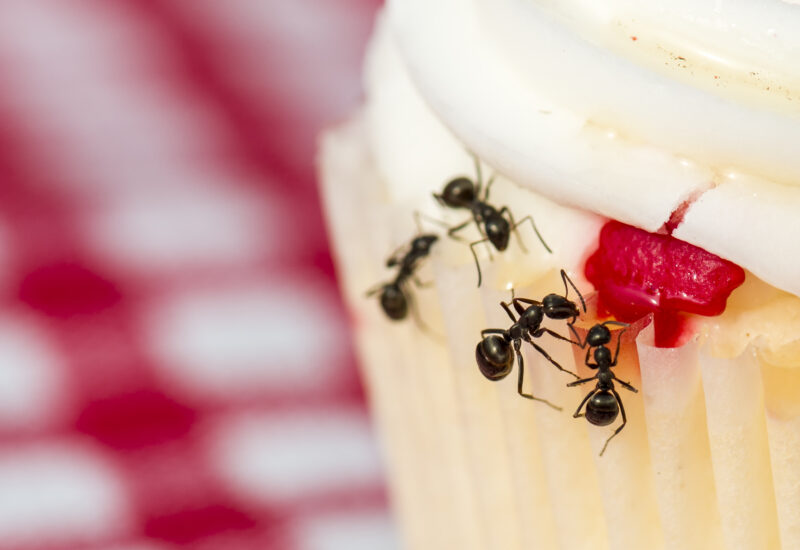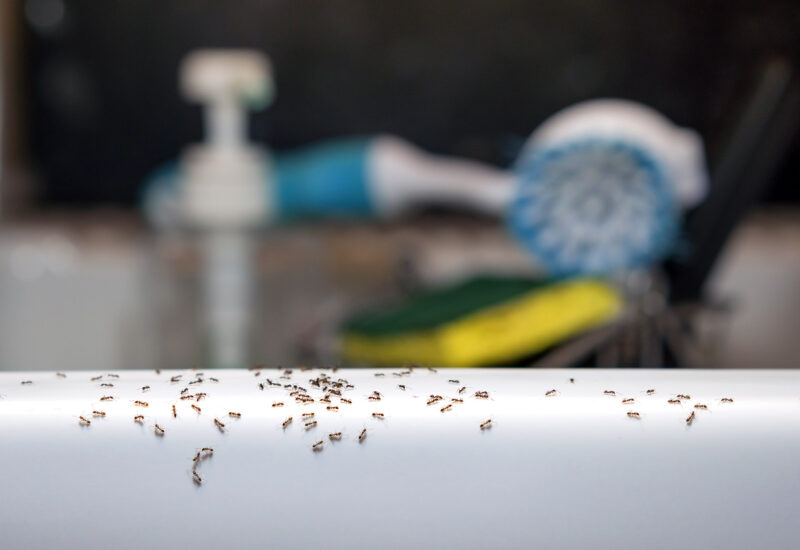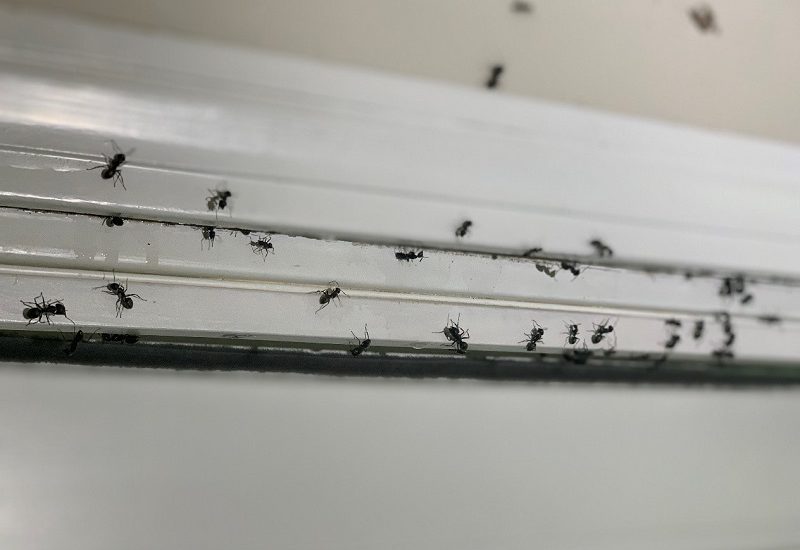Difference Between Carpenter Ants & Carpenter Bees

Figure Out Which Wood-Eating Insect is Causing Damage to Your Home
Have you noticed a bee hovering around your roof, deck, or lawn furniture?
It’s very possible you might have a new neighbor, the carpenter bee. Unlike a bumblebee, carpenter bees are not very social and live in solitude, meaning they won’t swarm around you or your home. They may look similar in size and shape, but a carpenter bee has a shiny, black abdomen with little to no hair. A bumblebee’s abdomen is covered by soft, fuzzy hair with bands of alternating black and yellow stripes.
Carpenter bees do pollinate plants, though not to the scale as bumblebees do, and are still important to the pollination process.
Where Do Carpenter Bees Live?
While bumblebees will nest in the ground, carpenter bees choose to create small holes inside exposed or untreated wood. They do not eat the wood, but merely drill holes into it to build nests. Windowsills, porches, roofs, and outdoor wooden furniture are all likely places for carpenter bees to make their home.
The carpenter bee doesn’t live in a colony like a bumblebee does either. It is solitary, and at most, a male and female carpenter bee will share the same space only until they mate. The male carpenter bee will hover outside the hole of the nest to protect it from other males. The female carpenter bees stay inside the hole, perfecting upon the structure of the nest and giving birth. The nest can get as big as 2 to 4 feet per season.
Once the male and female have completed their individual tasks, they will eventually die off, and the cycle will then continue with the younger generations inside the nest.
Do Carpenter Bees Sting?
Male carpenter bees do not have a stinger, so they cannot sting you.
They may act aggressive towards you if they feel that you are a threat to their nest, but they pose no real harm. A female carpenter bee, while she does have a stinger, typically remains inside the nest, so unless provoked, she won’t sting a human.
 Damage Caused by Carpenter Bees
Damage Caused by Carpenter Bees
Carpenter bees won’t initially cause a lot of structural damage to your home. However, if not taken care of, over time greater numbers of bees drilling holes and creating tunnels inside the wood over many years can cause significant damage. Woodpeckers, the natural predator to carpenter bees, can also cause extensive damage when looking for food inside of the tunnels.
Carpenter Bee Prevention
Keeping carpenter bees away from your home can be a daunting task. For one, the bees don’t actually eat the wood, so any pesticides you spray on wood surfaces aren’t guaranteed to be effective. Plus, those same sprays only last for short periods of time, while it may take weeks for the carpenter bee to finish building its nest. Also, since there are so many areas of wood that can be susceptible for infestation, it is almost impossible to ensure every area in your home is protected.
Replacing wood paneling and siding with other materials like vinyl can help reduce the risks of carpenter bees taking up residence in your home. However, the cost of something like this might not be optimal.
Carpenter Ants
Carpenter ants, especially the black carpenter ant, are the most common nuisance humans encounter inside their home. There are several different types of carpenter ants, each with their own distinct characteristics.
Where Do Carpenter Ants Live?
Carpenter ants, much like carpenter bees, do not eat the wood they inhabit, like termites do. Preferring damp, decayed, or hollow wood, carpenter ants can reside indoors or outdoors when the environment is suitable for them. The places around a home that are most susceptible to carpenter ants are porches, under windows, and roofs.
Carpenter ants will create passageways or tunnels throughout the wood in your home to move from section to section. These tunnels can become quite elaborate, connecting each colony to a food source. A centralized colony is formed with many smaller ones built around it.
Do Carpenter Ants Bite?
Carpenter ants will bite if they feel their nests are being threatened. The carpenter ant possesses mandibles tough enough to bite through wood, so it is possible for them to break through skin with their bites. Carpenter ant bites can be painful, leaving red pea-sized marks. Carpenter ants also have the ability of spraying a formic acid inside the bite, causing more pain. The acid is the same that can be found in bee stings. Carpenter ant bites are not venomous or contain any diseases so while causing some discomfort, there are no health risks associated with them.
Clean carpenter ant bites immediately after with soap and water. Use antibiotic cream, try to avoid itching, and apply a bandage if necessary.
Damage Caused by Carpenter Ants 
The damage caused by carpenter ants can be extensive, especially if infestations go unnoticed for a long period of time. If you do notice carpenter ants, it typically means you have a buildup of moisture somewhere throughout your house. Dishwashers, kitchen sinks, bathrooms, and leaky pipes are good places for carpenter ants to build their nests.
Over time as the colonies grow, carpenter ants build more tunnels in the wood. This increases the damage they cause and can be quite severe and costly to repair. Performing routine maintenance and repairs to your home can help to keep certain areas dry, making it less attractive to carpenter ants in the first place.
Getting Rid of Carpenter Ants
If a carpenter ant nest has been found inside your home, you may be able to simply remove the nest. However, if you can’t, you can use a vacuum to suck up the ants around the nest. Dispose of the bag to ensure none of the ants get free. Remember, carpenter ants tend to build other nests nearby, connected by tunnels so the possibility that there is a bigger infestation remains. You’ll want to consult with a specialist for carpenter ant control if you believe this to be the case.
Hiring a Pest Professional
If you think you have a problem with either carpenter bees or carpenter ants inside your home, it’s advised that you seek the help of a trained professional.
A pest management professional has the education, experience, equipment, and skills necessary to effectively address these problems. We’ll work with you to make sure any carpenter bees or carpenter ants are effectively removed from your home or yard, ensuring your home and family are safe.


 Damage Caused by Carpenter Bees
Damage Caused by Carpenter Bees




